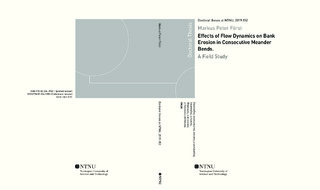| dc.contributor.author | Först, Markus Peter | |
| dc.date.accessioned | 2019-08-22T08:34:01Z | |
| dc.date.available | 2019-08-22T08:34:01Z | |
| dc.date.issued | 2019 | |
| dc.identifier.isbn | 978-82-326-3903-8 | |
| dc.identifier.issn | 1503-8181 | |
| dc.identifier.uri | http://hdl.handle.net/11250/2609765 | |
| dc.description.abstract | The present dissertation describes the influence of natural alteration in the rivers flow regime on the change of morphology of a freely meandering river in Norway. It consists of a thesis and four attached research papers. Erosion along riverbanks is an important issue due to loss of soil, wildlife habitat, pollution or reservoirfilling.
The interest in the erosion processes, lies in the huge economical and environmental damage happening each year. Bank failure is mainly driven by mass failure and fluvial erosion processes.
This thesis and research has focused on two different research sites. One site is a river bend located in middle Norway with some erosion protection near infrastructure. The other site is a meandering river located in northern Norway. This river is without erosion protection. Both sites are situated in unregulated catchments. This work investigates the fluvial erosion process in natural rivers at a microscale.
Methods used, are Terrestrial Laser Scanner (TLS) in order to monitor changes in river bank morphology. The bathymetry has been mapped with Real Time Kinetic GPS (RTK-GPS) and Acoustic Doppler Current Profiler (ADCP) measurements. The sediment properties of a two layer river bank has been analyzed.
The numerical model CONservational Channel Evolution and Pollutant Transport System (CONCEPTS) has been used to model the bank retreat at the river in middle Norway. The results showed that this model is not suitable for arctic climates.
For the second site, transect across three meanders in the river have been measured with an ADCP as moving boat transects and stationary. The data has been post processed by distance averaging. This new method for post processing of flow data from an ADCP made it possible to identify different flow structures in nature. These flow structures were the high velocity cell, the secondary current and the secondary outer cell. Their behavior has been compared to the bathymetry of the river. The nonconformity between water flows and bathymetry indicates that the bathymetry is strongly influenced by the hydraulic. Later calculations of shear stress from stationary ADCP measurements confirm this assumption. These data also showed a link between the movement of the high velocity cell and the appearance of the secondary outer cell. The observation of the secondary outer cell and the erosion and sedimentation along the cut bank leads to the assumption that the secondary outer cell reduces the fluvial erosion. Observed flash floods, which had no effect on erosion, might be explained by this phenomenon | nb_NO |
| dc.language.iso | eng | nb_NO |
| dc.publisher | NTNU | nb_NO |
| dc.relation.ispartofseries | Doctoral theses at NTNU;2019:152 | |
| dc.relation.haspart | Paper 1: Foerst, Markus; Ruther, Nils; Hahn, Felix. Evaluating erosion processes of a two-layer river banks. 7th IAHR Symposium on River, Coastal and Estuarine Morphodynamics | nb_NO |
| dc.relation.haspart | Paper 2: Foerst, Markus; Ruther, Nils. Post Processing Methods of Moving Boat ADCP Measurements Time Averaging vs. Distance Averaging. Berichte des Lehrstuhls und der Versuchsanstalt für Wasserbau und Wasserwirtschaft 2012 ;Volum 125. s. 183-189 | nb_NO |
| dc.relation.haspart | Paper 3: Foerst, Markus; Ruther, Nils. Mean and turbulent flow structures in two consecutive meander bends. 2nd IAHR Europe Conference; 2012 | nb_NO |
| dc.relation.haspart | Paper 4: Foerst, Markus; Ruther, Nils. Bank Retreat and Streambank Morphology of a Meandering River during Summer and Single Flood Events in Northern Norway. Hydrology 2018 ;Volum 5.(4) s. 1-16
- This is an open access article distributed under the Creative Commons Attribution License which permits unrestricted use, distribution, and reproduction in any medium, provided the original work is properly cited (CC BY 4.0).
https://doi.org/10.3390/hydrology5040068 | nb_NO |
| dc.title | Effects of Flow Dynamics on Bank Erosion in Consecutive Meander Bends - A Field Study | nb_NO |
| dc.type | Doctoral thesis | nb_NO |
| dc.subject.nsi | VDP::Technology: 500::Environmental engineering: 610 | nb_NO |
